
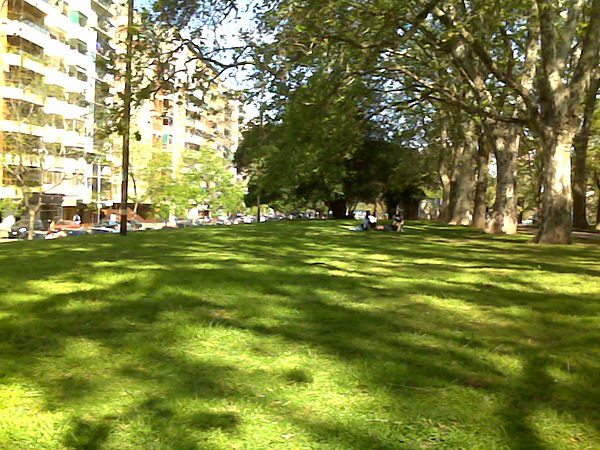
Chacabuco Park is a public park in the Parque Chacabuco section of Buenos Aires.


Chacabuco Park is a public park in the Parque Chacabuco section of Buenos Aires.
Situated over 3 mi (5 km) west of colonial Buenos Aires, land belonging to Jesuits was expropriated following their 1767 Papal suppression. The extensive plot was sold to a gunpowder maker in 1781, remaining in that use until the municipality purchased it in 1898. [1] A May 15, 1903, city ordinance provided for the demolition of what had become a gunpowder dump, and outlined a future, 20 hectare (50 acre) park at the site. The facility itself was planned by the City Parks Commissioner, the noted French Argentine urbanist Charles Thays, and was opened in 1909. Named in honor of the pivotal 1817 Battle of Chacabuco, it originally featured ornate entry gates, three football fields, as well as selected business installations, such as a dairy, bookstore and tree nursery. [2]
A number of athletic grounds were installed at the park in 1911, including a running track, tennis courts, swimming pools, and a bocce court. A school for special education was installed around 1920 and is still operated there, as are two primary schools and a physical education facility. One of the special education school's noted instructors was the ill-fated poet, Alfonsina Storni. [2]
The park became well known for its floral variety and selection of decorative sculptures, as well. A rose garden featuring over 3,000 varietals was maintained alongside the nursery, and after 1930, numerous memorial and naturalist sculptures were installed, including monuments to José de San Martín, Domingo Sarmiento and Frédéric Chopin, as well as naturalist works evoking the ceremonial Inca maidens (the Ñusta), a jaguar, and others. [3] The park was further complemented by the 1941 opening of the Church of Our Lady of the Miraculous Medal. [4]
The planned construction of a network of intra-city freeways by the last dictatorship's Mayor, Osvaldo Cacciatore, led to the 1978 destruction of a wide, diagonal swath through the park. [1] The damage to the park (the area's principal green space) was only partially remedied by the 1981 opening of a sports complex and the 1984 construction of a cultural center under the freeway, itself. [4] Works initiated in January 2008 on new freeway on-ramps and off-ramps met with steadfast opposition from neighborhood groups, and their construction was suspended pending review. [1]

Caballito is a barrio (neighborhood) of the Argentine capital, Buenos Aires. It is the only barrio in the administrative division Comuna 6.

Barracas is a barrio, or district, in the southeast part of the city of Buenos Aires, Argentina. It is located between the railroad of Ferrocarril General Manuel Belgrano and the Riachuelo River, and the streets Regimiento de Patricios, Defensa, Caseros, Vélez Sársfield, Amancio Alcorta, Lafayette, and Lavardén. The name Barracas comes from the word barraca, which refers to a temporary construction of houses using rudimentary materials.
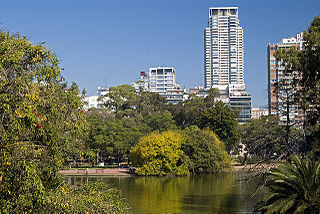
Parque Tres de Febrero, popularly known as Bosques de Palermo, is an urban park of approximately 400 hectares located in the neighborhood of Palermo in Buenos Aires, Argentina. Located between Libertador and Figueroa Alcorta Avenues, it is known for its groves, lakes, and rose gardens.

Parque Patricios is a barrio located on the southern side of Buenos Aires, Argentina belonging to the fourth comuna.

Villa Soldati is a neighbourhood in Buenos Aires, Argentina, located in the South-West of the city. It has a population of approximately 41,000 people, 40% of which live in Barrio Soldati, a public housing development built between 1973 and 1979.

Saavedra is a barrio (neighbourhood) of Buenos Aires, Argentina. It is located in the Northern end of the city, close to Belgrano and Villa Urquiza. Its northern border is Avenida General Paz. Among the main features of the neighbourhood is the Parque Saavedra, which has large picnic areas and sports facilities. Many inhabitants of Buenos Aires pass through Saavedra en route to their weekends in the country.

The Remembrance park is a public space situated in front of the Río de la Plata estuary in the northern end of the Belgrano section of Buenos Aires. It is a memorial to the victims of the 1976–83 military regime, known as the National Reorganization Process, during the Dirty War, a period of unprecedented state-sponsored violence in Argentina.
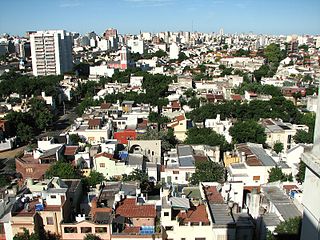
Parque Chacabuco is a neighbourhood in Buenos Aires, Argentina. Its name is due to Chacabuco Park, which is in its centre, taking the name from the Battle of Chacabuco.

Villa del Parque is a barrio (neighbourhood) or district within the city of Buenos Aires, Argentina. Its name translates as Village of the Park and was derived from its earliest beginnings, when several haciendas were all that existed, alongside a growing agricultural park in this section of Buenos Aires Province.

The Galileo Galilei planetarium, commonly known as Planetario, is located in Parque Tres de Febrero in the Palermo district of Buenos Aires, Argentina.

Avenida Figueroa Alcorta is a major thoroughfare in Buenos Aires, Argentina, with a length of over 7 km (4.3 mi) along the city's northside.
The Buenos Aires Japanese Gardens are a public space administered by the non-profit Japanese Argentine Cultural Foundation in Buenos Aires, Argentina, and are one of the largest Japanese gardens of its type in the world outside Japan.

Lezama Park is a public park in the San Telmo district of Buenos Aires, Argentina.
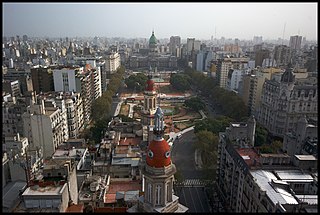
Congressional Plaza is a public park facing the Argentine Congress in Buenos Aires. The plaza is part of a 3 hectare open space comprising three adjoining plazas to the east of the Congress building. The Kilometre Zero for all Argentine National Highways is marked on a milestone at the Plaza.
Avellaneda Park is a public park in the Parque Avellaneda section of Buenos Aires.
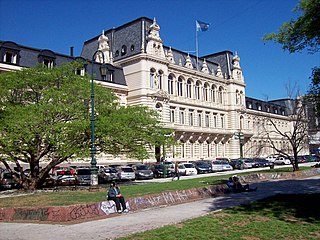
The Pizzurno Palace, as the "Sarmiento Palace" is commonly known, is an architectural landmark in the Recoleta section of Buenos Aires and the location of the Argentine Ministry of Education.

Floralis Genérica is a sculpture made of steel and aluminum located in Plaza de las Naciones Unidas, Avenida Figueroa Alcorta, Buenos Aires, a gift to the city by the Argentine architect Eduardo Catalano. Catalano once said that the flower "is a synthesis of all the flowers and, at the same time, a hope reborn every day at opening." It was created in 2002. The sculpture was designed to move, closing its petals in the evening and opening them in the morning.
Parque Indoamericano is a park in the Villa Soldati and Villa Lugano neighbourhoods of Buenos Aires, Argentina. It covers approximately 130 hectares, and is thus the second-biggest park in the city.
The Battle of Chacabuco was a decisive victory fought by Chilean and Argentine forces against the Spanish forces in Chile during the Chilean War of Independence in 1817. The name Chacabuco may also refer to:

The Avellaneda Park Historic Train, colloquially known as "Expreso Alegría" is a narrow gauge train that runs inside Avellaneda Park of Parque Avellaneda district, in the southwest of Buenos Aires, Argentina.